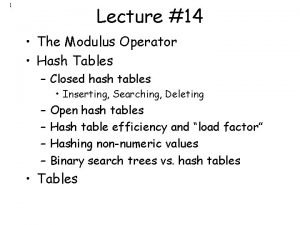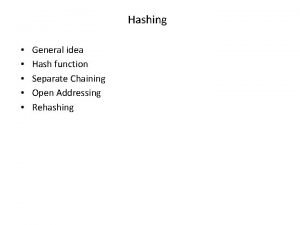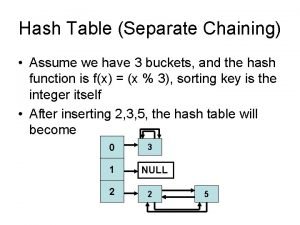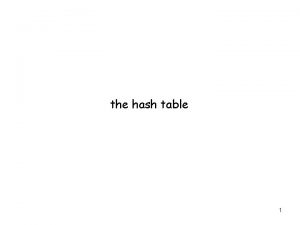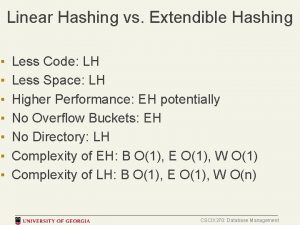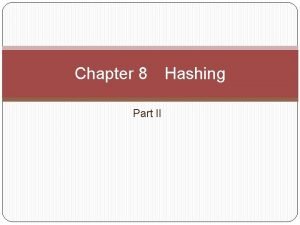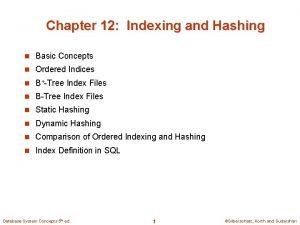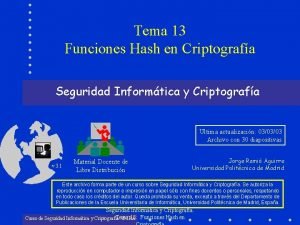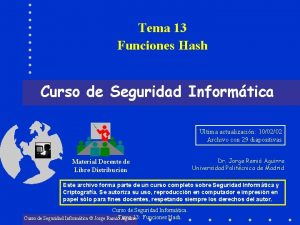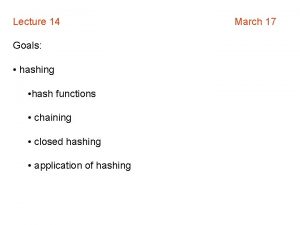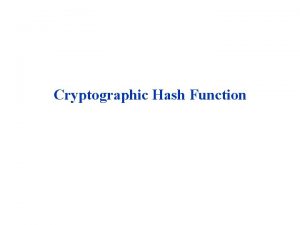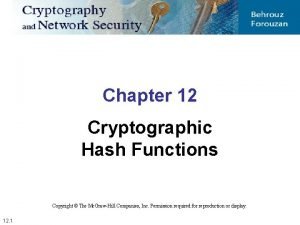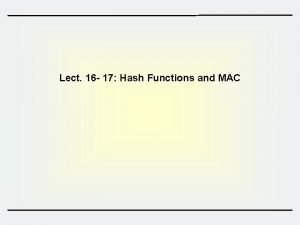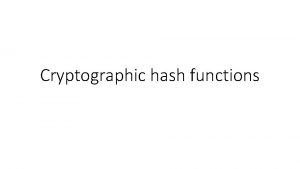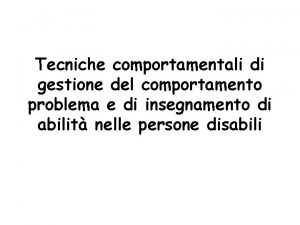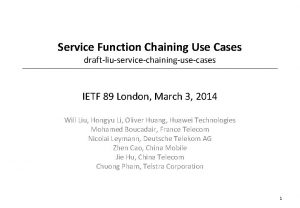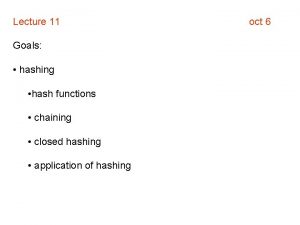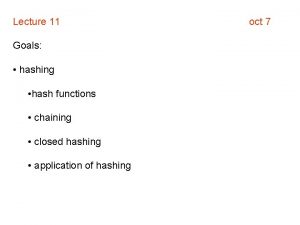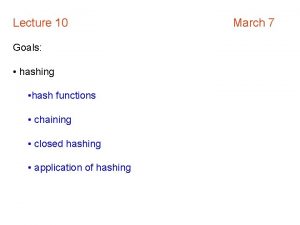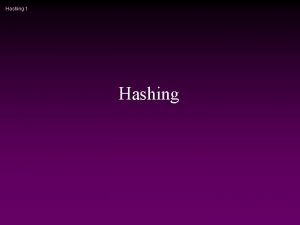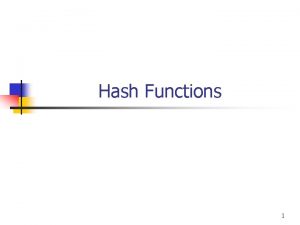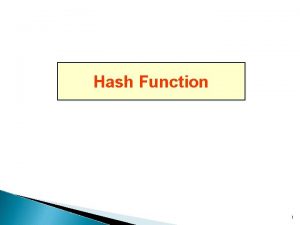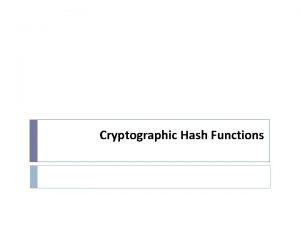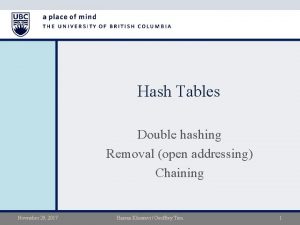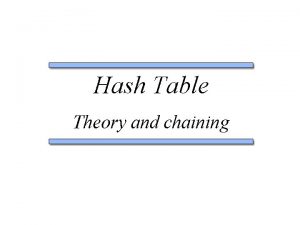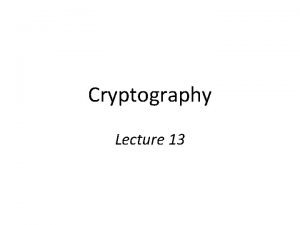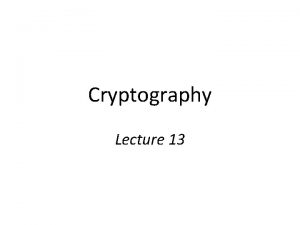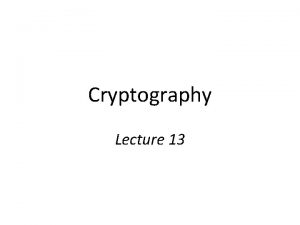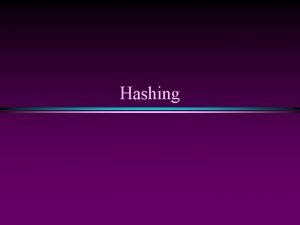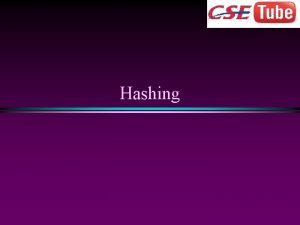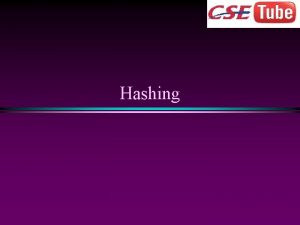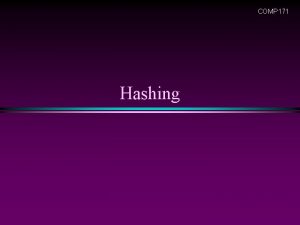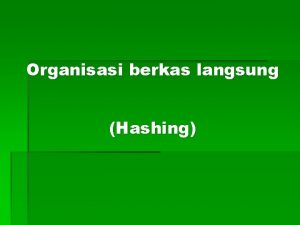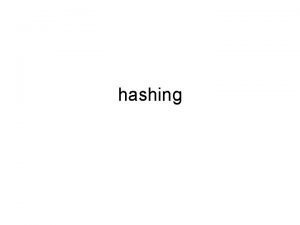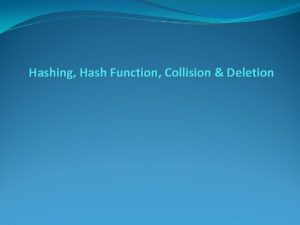Lecture 14 Goals hashing hash functions chaining closed
























- Slides: 24

Lecture 14 Goals: • hashing • hash functions • chaining • closed hashing • application of hashing March 17

Computing hash function for a string Horner’s rule: (( … (a 0 x + a 1) x + a 2) x + … + an-2 )x + an-1) int hash( const string & key ) { int hash. Val = 0; for( int i = 0; i < key. length( ); i++ ) hash. Val = 37 * hash. Val + key[ i ]; return hash. Val; }

Computing hash function for a string int myhash( const Hashed. Obj & x ) const { int hash. Val = hash( x ); hash. Val %= the. Lists. size( ); return hash. Val; } Alternatively, we can apply % the. Lists. size() after each iteration of the loop in hash function. int my. Hash( const string & key ) { int hash. Val = 0; int s = the. Lists. size(); for( int i = 0; i < key. length( ); i++ ) hash. Val = (37 * hash. Val + key[ i ]) % s; return hash. Val % s; }

Analysis of open hashing/chaining Open hashing uses more memory than open addressing (because of pointers), but is generally more efficient in terms of time. If the keys arriving are random and the hash function is good, keys will be nicely distributed to different buckets and so each list will be roughly the same size. Let n = the number of keys present in the hash table. m = the number of buckets (lists) in the hash table. If there are n elements in set, then each bucket will have roughly n/m If we can estimate n and choose m to be ~ n, then the average bucket will be O(1). (Most buckets will have a small number of items).

Analysis continued Average time per dictionary operation: m buckets, n elements in dictionary average n/m elements per bucket n/m = is called the load factor. insert, search, remove operation take O(1+n/m) = O(1 time each (1 for the hash function computation) If we can choose m ~ n, constant time per operation on average. (Assuming each element is likely to be hashed to any bucket, running time constant, independent of n. )

Closed Hashing Associated with closed hashing is a rehash strategy: “If we try to place x in bucket h(x) and find it occupied, find alternative location h 1(x), h 2(x), etc. Try each in order, if none empty table is full, ” h(x) is called home bucket Simplest rehash strategy is called linear hashing hi(x) = (h(x) + i) % m In general, our collision resolution strategy is to generate a sequence of hash table slots (probe sequence) that can hold the record; test each slot until find empty one (probing)

Closed Hashing (open addressing) Example: m = 8, keys a, b, c, d have hash values h(a)=3, h(b)=0, h(c)=4, h(d)=3 Where do we insert d? 3 already filled 0 Probe sequence using linear hashing: h 1(d) = (h(d)+1)%8 = 4 h 2(d) = (h(d)+2)%8 = 5* h 3(d) = (h(d)+3)%8 = 6 Etc. 1 2 3 4 a c 5 d 6 Wraps around to the beginning of the table b 7

Operations Using Linear Hashing Test for membership: search Examine h(k), h 1(k), h 2(k), …, until we find k or an empty bucket or home bucket case 1: successful search -> return true case 2: unsuccessful search -> false case 3: unsuccessful search and table is full If deletions are not allowed, strategy works! What if deletions?

Operations Using Linear Hashing What if deletions? If we reach empty bucket, cannot be sure that k is not somewhere else and empty bucket was occupied when k was inserted Need special placeholder deleted, to distinguish bucket that was never used from one that once held a value

Implementation of closed hashing Code slightly modified from the text. // CONSTRUCTION: an approximate initial size or default of 101 // // *********PUBLIC OPERATIONS*********** // bool insert( x ) --> Insert x // bool remove( x ) --> Remove x // bool contains( x ) --> Return true if x is present // void make. Empty( ) --> Remove all items // int hash( string str ) --> Global method to hash strings There is no distinction between hash function used in closed hashing and open hashing. (I. e. , they can be used in either context interchangeably. )

template <typename Hashed. Obj> class Hash. Table { public: Hash. Table( next. Prime( size )) { make. Empty( ); } bool contains( const Hashed. Obj & x ) const { return is. Active( find. Pos( x ) ); } void make. Empty( ) { current. Size = 0; for( int i = 0; i < array. size( ); i++ ) array[ i ]. info = EMPTY; }

bool insert( const Hashed. Obj & x ) { int current. Pos = find. Pos( x ); if( is. Active( current. Pos ) ) return false; array[ current. Pos ] = Hash. Entry( x, ACTIVE ); if( ++current. Size > array. size( ) / 2 ) rehash( ); // rehash when load factor exceeds 0. 5 return true; } bool remove( const Hashed. Obj & x ) { int current. Pos = find. Pos( x ); if( !is. Active( current. Pos ) ) return false; array[ current. Pos ]. info = DELETED; return true; } enum Entry. Type { ACTIVE, EMPTY, DELETED };

private: struct Hash. Entry { Hashed. Obj element; Entry. Type info; }; vector<Hash. Entry> array; int current. Size; bool is. Active( int current. Pos ) const { return array[ current. Pos ]. info == ACTIVE; }

int find. Pos( const Hashed. Obj & x ) { int offset = 1; // int offset = s_hash(x); /* double hashing */ int current. Pos = myhash( x ); while( array[ current. Pos ]. info != EMPTY && array[ current. Pos ]. element != x ) { current. Pos += offset; // offset += 2 // Compute ith probe /* quadratic probing if( current. Pos >= array. size( ) ) current. Pos -= array. size( ); } return current. Pos; } How should the code be modified if table can be full? */

Performance Analysis - Worst Case Initialization: O(m), m = # of buckets Insert and search: O(n), n number of elements currently in the table Suppose there are close to n elements in the table that form a chain. Now want to search x, and say x is not in the table. It may happen that h(x) = start address of a very long chain. Then, it will take O(c) time to conclude failure. c ~ n. No better than linear list for maintaining dictionary! THIS IS NOT A RARE OCCURRENCE WHEN THE TABLE IS NEARLY FULL. (this is why we rehash when reaches some value like 0. 5)

Example I 0 1001 1 9537 2 3016 3 4 5 6 7 9874 8 2009 9 9875 10 1. What if next element has home bucketh(k) 0? = k%11 = 0 go to bucket 3 Same for elements with home bucket 1 or 2! Only a record with home position 3 will stay. p = 4/11 that next record will go to bucket 3 2. Similarly, records hashing to 7, 8, 9 will end up in 10 3. Only records hashing to 4 will end up in 4 (p=1/11); same for 5 and 6 II insert 1052 (h. b. 7) 0 1001 1 9537 2 3016 3 4 5 6 7 9874 8 2009 9 9875 10 1052 next element in bucket 3 with p = 8/11

Performance Analysis - Average Case Distinguish between successful and unsuccessful searches Delete = successful search for record to be deleted Insert = unsuccessful search along its probe sequence Expected cost of hashing is a function of how full the table is: load factor = n/m

Random probing model vs. linear probing model • It can be shown that average costs under linear hashing (probing) are: • Insertion: 1/2(1 + 1/(1 - )2) • Deletion: 1/2(1 + 1/(1 - )) • Random probing: Suppose we use the following approach: we create a sequence of hash functions h, h, … all of which are independent of each other. • insertion: 1/(1 – ) • deletion: 1/ log(1/ (1 – ))

Random probing – analysis of insertion (unsuccessful search) What is the expected number of times one should roll a die before getting 4? Answer: 6 (probability of success = 1/6. ) More generally, if the probability of success = p, expected number of times you repeat until you succeed is 1/p. Probes are assumed to be independent. Success in the case of insertion involves finding an empty slot to insert.

Proof for the case insertion: 1/(1 – ) Recall: geometric distribution involves a sequence of independent random experiments, each with outcome success (with prob = p) or failure (with prob = 1 – p). We repeat the experiment until we get success. The question is: what is the expected number of trials performed? Answer: 1/p In case of insertion, success involves finding an empty slot. Probability of success is thus 1 – . Thus, the expected number of probes = 1/(1 – )

Improved Collision Resolution Linear probing: hi(x) = (h(x) + i) % D all buckets in table will be candidates for inserting a new record before the probe sequence returns to home position clustering of records, leads to long probing sequence Linear probing with increment c > 1: hi(x) = (h(x) + ic) % D c constant other than 1 records with adjacent home buckets will not follow same probe sequence Double hashing: hi(x) = (h(x) + i g(x)) % D G is another hash function that is used as the increment amount. Avoids clustering problems associated with linear probing.

Comparison with Closed Hashing Worst case performance is O(n) for both. Average case is a small constant in both cases when is small. Closed hashing – uses less space. Open hashing – behavior is not sensitive to load factor. Also no need to resize the table since memory is dynamically allocated.


 What is open hashing and closed hashing
What is open hashing and closed hashing Backward chaining
Backward chaining Re-hashing
Re-hashing Separate chaining hash table
Separate chaining hash table Hash separate chaining
Hash separate chaining Extendible hashing vs linear hashing
Extendible hashing vs linear hashing Dynamic hashing
Dynamic hashing Static hashing and dynamic hashing
Static hashing and dynamic hashing Tema de hash hash
Tema de hash hash Tema de hash hash
Tema de hash hash Strategic goals tactical goals operational goals
Strategic goals tactical goals operational goals Strategic goals tactical goals operational goals
Strategic goals tactical goals operational goals Hash goals
Hash goals Off delay timer symbol
Off delay timer symbol Cryptographic hash functions
Cryptographic hash functions Hash functions
Hash functions Hash functions
Hash functions Hash functions
Hash functions Hash functions
Hash functions 01:640:244 lecture notes - lecture 15: plat, idah, farad
01:640:244 lecture notes - lecture 15: plat, idah, farad General goals and specific goals
General goals and specific goals Motivation in consumer behaviour
Motivation in consumer behaviour Shaping e chaining esempio
Shaping e chaining esempio Backward chaining occupational therapy
Backward chaining occupational therapy Service chaining use cases
Service chaining use cases
